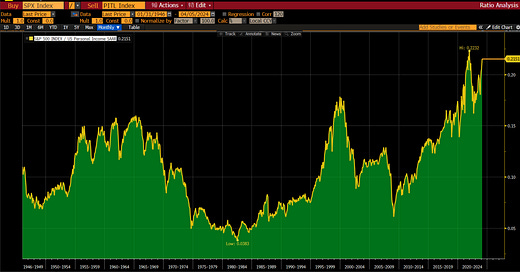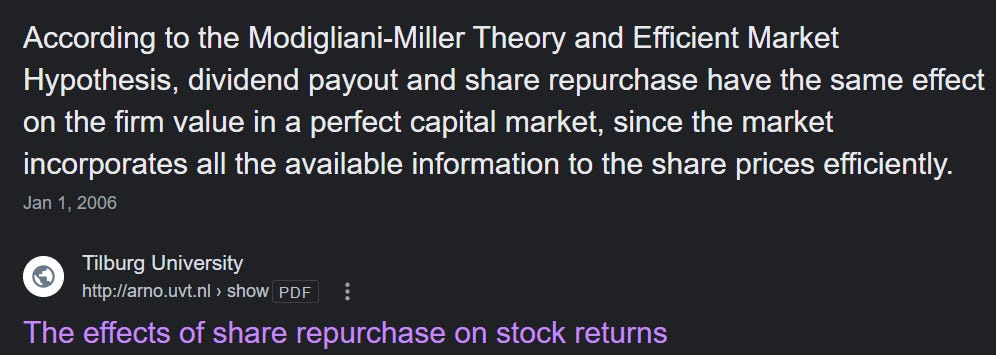Summary:
Common financial theories about corporate share buybacks and their impact on market dynamics are flawed on both sides. The Modigliani Miller dividend irrelevance theorem is irrelevant in practice and do not account for the realities of market operation.
The nature of the shareholder base and the company's dividend policy significantly affect the market impact of buybacks, and inelastic markets are key to shaping stock prices and market movements. Dividends and buybacks are not equivalent in their effect on markets, challenging prevailing financial theories and practices.
Institutional Subscribers: Last week’s recording was corrupted, and I apologize. If there is interest, I’m happy to host a second call on Friday, April 19th. Please reach out directly and let me know.
Due to Delay, No Top Comment
I had hoped this was going to be one of my shorter notes as I’m typing from an armchair in Annapolis, MD, during a short visit rather than sitting at any of my dozen temporary desks over the past year. The next few weeks are chaotic, to say the least, with trips to Annapolis, Miami, San Francisco, Raleigh-Durham, Charleston (SC), Greenville (SC), Savannah (GA), New York, and Connecticut. With wife and dogs for much of the travel. Wish me luck.
The Main Event
While I had planned on writing on gold (and have the post 90% done), this past week I had one of my favorite “passive” discussions with Ben Felix and Cameron Passmore of PWL Capital up in Canada and this has pushed me in a different direction. While I have no meaningful knowledge of their firm, I will frame Ben, the Head of Research at PWL, as the “anti-Batnick” despite their passing similitude and shared defense of passive investing. When I was first directed to Ben’s work, I wrote a slightly less mean version of the now archived “Cleanup on Aisle Four” (rewritten as “Be Better” if you’d like a refresher) that examined the errors in Ben’s analysis. You can find that piece here.
Ben and I also sparred over Twitter. And then email. And then we had the podcast. It appears it will be released on YouTube on April 25th on their Rational Reminder channel. I’m really looking forward to the reaction because BEN DID THE WORK. And guess what, he now understands. In a fatherly/professorial way, I’m extremely proud of him. Unfortunately, he also recognizes, as I continually emphasize, that there’s really nothing an individual investor (or wealth management firm) can do. Passive investing IS breaking markets, and the results will prove catastrophic. But until then, it’s almost mathematically guaranteed to outperform active management. Exactly WHEN and exactly WHAT is the catalyst that pricks the bubble is unknowable, but it IS coming. We discuss some of the reasons during the podcast, but the simplest answer is that withdrawals are a function of asset levels while contributions are a function of incomes. Eventually, the withdrawals will swamp the contributions, and the system will start to fall. Unfortunately, with asset levels now higher relative to incomes than ever in history, we know we’re closer to the end than the beginning of this story. I wish we weren’t, but we are.
While I don’t think there is anything individuals can do, other than raise awareness and understanding, I do share my recommendations. If you happen to make it through any of my in-person presentations, you’ll find this slide:
Note the highlighted policy recommendation #5. One of the reasons the current environment has persisted is the growing role of corporate share buybacks in providing both competition and support for traded shares. Anyone worth their salt in the finance industry has at least a rudimentary familiarity with the Modigliani Miller dividend irrelevance theorem and the implications for stock buybacks:
Now regular readers of my work will immediately gravitate to the warning flags — “perfect capital market” and Efficient Market Hypothesis. For those who might not know the definition of a “perfect” capital market:
Well, that sounds a lot like the markets I know and love. No entry barriers, no transaction costs, no tax differentials, equal access to borrowing and lending opportunities… and firm value absolutely equal to the PV of cash flows…. Excuse me for a moment…
Keep reading with a 7-day free trial
Subscribe to Yes, I give a fig... thoughts on markets from Michael Green to keep reading this post and get 7 days of free access to the full post archives.







